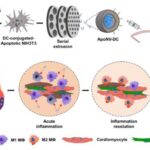
Researcher at K. G. Jebsen — Center for Exercise in Medicine (CERG), and first author of the study, Anja Bye. Credit: Andrea Hegdahl Tiltnes/NTNU
New Biomarkers can help ID a person’s risk of getting cardiac disease with greater precision than traditional risk factors alone. When you visit your GP you can get your blood analyzed for cholesterol and triglycerides, to get an idea of your risk for cardiovascular disease. With additional information about BMI, smoking habits and blood pressure, this can be used to calculate your 10-yr risk for cardiovascular disease. However, the use of risk prediction calculators has declined in the primary care setting because the currently available calculators only explain a modest proportion of the incidence. For myocardial infarction, it 15-20% of the patients had none of the traditional risk factors and would be classified as “low risk.”
“Our study showed that by measuring a combination of 5 different microRNAs and adding this information to the traditional risk factors for cardiovascular disease, we could identify those that were going to experience a myocardial infarction with considerably improved precision,” says Anja Bye, NTNU.
There have been several attempts during the last years to improve the risk prediction calculators by adding bio markers. Some calculators add inflammation marker, CRP (C-reactive protein) or a diabetic marker HbA1c (glycosylated hemoglobin). This increases the accuracy of the calculators, but still there is a need for new cardiovascular bio markers that could complement the assessment of traditional risk factors, for greater precision. It was based on this that they designed this study to explore the possibility of a new type of bio marker called circulating microRNAs, to predict 10-year risk for myocardial infarction.
They included 212 healthy participants (40-70 years) from the Nord-Trøndelag Health Study 2 (HUNT2, blood collected in 1996) that either died from myocardial infarction within 10 years or remained healthy at the time of HUNT3 (2006). 179 different microRNAs were quantified in blood samples from these participants.
“For all bio marker studies, replication of the results in new studies is essential to determine the strength of the bio markers, and to evaluate the potential use in a clinical setting. This is why we have initiated a new study, in collaboration with Karolinska Institutet, to further test these microRNAs in new participants from the HUNT study,” Bye says. They expect to have the new results ready for publication in January 2017. https://cergntnu.wordpress.com/2016/06/28/your-blood-can-reveal-your-risk-for-heart-disease/








Recent Comments